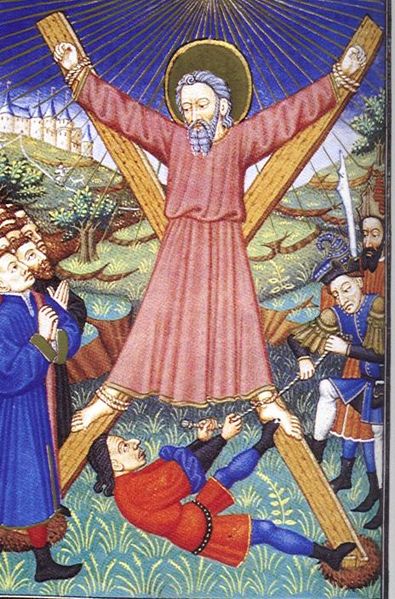
The 30th of November is celebrated by Christians across the world as Saint Andrew’s day; remembering the day that Andrew, one of the Jesus’ twelve apostles, was martyred by crucifixion on an X-shaped cross, also known now as a ‘St Andrew’s Cross’, in Patras, in Greece.
However, for Scots, the day is more about celebrating and embracing their culture and heritage, and basically everything Scottish, rather than the traditional acknowledement of a Christian hero’s sacrifice, and his actual connection with Scotland.
Though Saint Andrew is not only the patron saint of Scotland, but of Russia, Ukraine, Greece, and Romania amongst other places, plus of fishermen and singers too.
Born around sometime in the very early part of the first century AD, Andrew, along with his brother Saint Peter, was a fisher from Bethsaida, on the sea of Galilee. He was a disciple of John the Baptist and is said to have been the very first of Jesus’ twelve apostles.
Tradition has it that Andrew travelled around, carrying out missionary work, particularly around the Black Sea. It’s claimed that he even travelled as far as Kiev and the Volga, hence how he become patron saint of countries such as Russia and the Ukraine.
Andrew was martyred in Patras sometime between 60 and 70AD. He was crucified (though records suggest that he was bound with rope rathern than nailed on) on an X-shaped cross, however, it isn’t until sometime in the tenth century, at the earliest, that his cross is described as being shaped diagonally.
Just like many important saints, Andrew’s remains weren’t left in peace, but instead, according to Saint Jerome, were taken from Patras to Constantinople sometime in the fourth century. They were removed by order of Roman emperor, Constantine, but a few body parts were saved and taken to Scotland by Saint Rule (also known as St Regulus) before they reached Constantinople. Legend has it that Rule was warned by an angel to move as much of the body as possible and take it for safekeeping as far away as possible. On his journey he was shipwrecked off the Fife coast and came ashore where the modern-day town of St Andrews now is, and was welcomed by the Pictish king.
The relics (claimed to be three fingers from Andrew’s right hand, a knee-cap, the upper bone of an arm, and a tooth) were held at a monastery in St Andrews, but were likely to have been destroyed during the Scottish Reformation in the 16th century.
The rest of the body was moved to Constantinople, but in 1208, following the sack of Constantinople, they were taken to the Cathedral of Sant’ Andrea in the Italian town of Amalfi, and sometime during the 15th century Andrew’s head was taken to St. Peter’s Basilica in the Vatican.
Saint Andrew has been recognised as Scotland’s patron saint since as early as 1320 at the signing of the Declaration of Arbroath, believing that having an apostle of Jesus (a heavy-weight Saint) as patron of the country would help with independence on the religious front. However, there is a legend that sees Saint Andrew being made the patron saint in 832AD, at the battle of Athelstaneford between the Scots and the Angles. It is said that not long before the battle the king of the Scots prayed for help from Saint Andrew, and vowed, after seeing white clouds form an X-shape in the blue sky, that if his army were victorious he would proclaim Andrew the country’s patron saint. The Scots won the battle against their southern enemy, putting it down to the blessing from Saint Andrew, and in turn adopted the white cross on the blue background as their flag and Saint Andrew as their patron saint.
In more recent times other relics of Saint Andrew have been given to Scotland. In 1879, the Archbishop of Amalfi sent one of Saint Andrew’s shoulder blades to the re-established Catholic community in Scotland, whilst in 1969, Gordon Gray was in Rome to be appointed as the first Cardinal in Scotland since the Reformation, and was given some relics of Saint Andrew with the words “Saint Peter gives you his brother.” They are on display at St. Mary’s Roman Catholic Cathedral in Edinburgh.
Saint Andrew has been recognised as Scotland’s patron saint since as early as 1320 at the signing of the Declaration of Arbroath, believing that having an apostle of Jesus (considered a heavy-weight Saint) as patron of the country would help with independence on the religious front. However, there is a legend that sees Saint Andrew being made the patron saint in 832AD, at the battle of Athelstaneford between the Scots and the Angles. It is said that not long before the battle the king of the Scots prayed for help from Saint Andrew, and vowed, after seeing white clouds form an X-shape in the blue sky, that if his army were victorious he would proclaim Andrew the country’s patron saint. The Scots won the battle against their southern enemy, putting it down to the blessing from Saint Andrew, and in turn adopted the white cross on the blue background as their flag and Saint Andrew as their patron saint.
